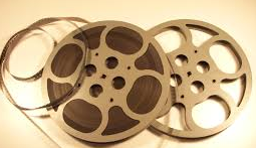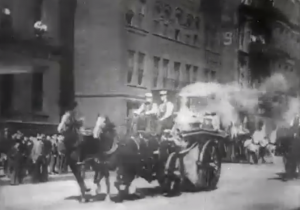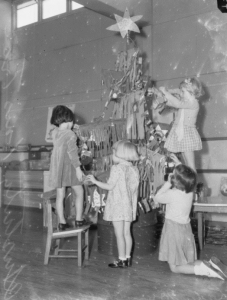Researching Historical Novels Through Films
B.J. SEDLOCK
 The old saw, “A picture is worth a thousand words” really does have relevance in historical research. I’m sure that novelists will find that a film clip showing a 1903 fire truck in action to be more valuable than reading a text description, not to mention more interesting.
The old saw, “A picture is worth a thousand words” really does have relevance in historical research. I’m sure that novelists will find that a film clip showing a 1903 fire truck in action to be more valuable than reading a text description, not to mention more interesting.
Here are websites which offer free digital videos of historical/documentary short films. I’ve highlighted some that will be of interest to writers researching a historical novel. Writers who aren’t sure what their next book will be about might find that these films will spark an idea.
The BFI website offers some films that provide interesting social history to authors setting novels in 20th century Britain. Some are available for free, but they apparently can only be viewed within the UK. When I tried (from the US) to play an individual title, I got an error message that it was not available outside the UK. Fellow HNS member jay Dixon sampled and described some of the offerings I couldn’t access:
Life in Britain: If you have a specific decade in mind, or specific occupation, or UK country, it is quite easy to search the site for the free films. You can also search for a specific town. Some show people at work, for instance the 1966 film about one of the last canal bargees shows him preparing the horse to pull the barge, and then travelling along the canal while he talks about his life. Others include LBGT themes, tennis and other sport on film, and films about the different UK countries, like haymaking in Wales in 1949, how the Scots cope with winter in 1960, and views of County Antrim in 1971.
Historical public Information films are available, which present interesting social history. A screamingly funny example is a film on how to be civil on the telephone from 1948. It demonstrates how NOT to be civil first, and then the second half shows correct telephone behavior.
Among the other offerings: films which teach children bicycle road safety (stop at junctions, don’t hold onto the back of a lorry), a film encouraging the 1947 public to spend their summer holiday working on a farm, a 1976 police recruitment film, a rather sad one on how to survive a nuclear attack in 1975, an AIDS awareness ad from 1987, and an animation from 1978 about keeping Britain tidy.
NOTE: BFI also offers some films on their YouTube channel, which can be viewed outside of the UK. See description below in the YouTube section of this article.
NATIONAL LIBRARY OF MEDICINE (U.S.), DIGITAL COLLECTIONS
Do you need to do some health-related historical research? Check out this site. To find the films, look under “refine by,” click on “formats” and then “moving image.”
This site is the NLM’s “free online repository of biomedical resources…freely available worldwide,” and most documents are in the public domain. All of the films offer English closed captions; just click on the little “cc” on screen after you click on the “play” arrow.

A still from “Home Nursing in Pneumonia,” 1940
National Library of Medicine
http://resource.nlm.nih.gov/8700082A
Are you writing a book set midcentury in which a character has to care for someone who is very ill? Home Nursing in Pneumonia, from 1940, shows in quite a bit of detail how very ill patients were cared for in pre-antibiotic days. Techniques such as how to change sheets while the patient remains in bed are demonstrated, and even bedpan methods (don’t worry, it’s demonstrated with a model).
Let My People Live, 1938, was aimed at African American audiences in the late Depression, to educate about modern treatments available for patients with tuberculosis. If you are writing a novel with an African American character in that era, this film touches on the skepticism of some people in the community towards the medical establishment. Just remember that the film is a dramatization.
Does your plot have a scene set in a 19th century scientific laboratory? Magic Bullets (1943) is about the work of Dr. Paul Ehrlich’s search for syphilis treatments in the late 1800s, starring Edward G. Robinson. While it’s a dramatization, not straight history, viewing the film can give an author ideas on 19th century medical scientists’ working conditions, and what a 19th century laboratory might look like. And if you have a character in your manuscript with syphilis in that time period, you might get insights into society’s attitude towards the disease in Ehrlich’s era.
Other gems in the NLM’s film database include videos on how diabetes was treated in 1949, prescribed hygiene for women serving in the armed forces in World War II and male soldiers serving in tropical areas, and interviews with teenagers in 1966 on why they take drugs.
The NLM’s website also has historical non-film treasures: you might be amused or maybe horrified at its collection of sometimes naughty postcards depicting nurses, a digitized version of an 1885 book on the treatment of acne, and over 600 documents on homeopathy.
LIBRARY OF CONGRESS, FILM/VIDEO COLLECTION
Historical films on life in the U.S. abound on the Library of Congress’ collection. This link takes you to the subset of the U.S. Library of Congress’s digital collections that contain historical films and videos. Some of the most intriguing for novelists include:
The Life of a City: Early Films of New York, 1898-1906
This collection has over 40 turn-of-the-century films shot in New York, with subjects such as immigrants arriving at Ellis Island, newsboys scrambling at the delivery wagon to get newspapers to sell on the street, views of the city from atop the new Times building in 1905, and business being conducted in a fish market in 1903. Any author setting a story in New York City at the turn of the previous century will want to view these films and check their story’s authenticity.
The Spanish American War in Motion Pictures
These were filmed between 1898 and 1901 in the U.S., Cuba and the Philippines. They depict a Rough Rider skirmish, saluting the colors on a Navy ship, President McKinley inspecting Camp Wikoff, insurgents facing a firing squad, and trained cavalry horses are put through their paces. Novelists setting a book during the Spanish American War will want to view these films.
Cleveland Fire Department, 1903.

A still from “Cleveland Fire Department,” 1903
http://hdl.loc.gov/loc.mbrsmi/awal.1536
This short film shows a drill by the fire department in Cleveland, Ohio. If you want to be able to accurately describe a turn-of-the-century fire truck, view this video to see the horse-drawn wagons, with steam billowing out behind as they race down the street. If you need to check on 1903 male fashions in the Midwest, there are several views of the watching crowd.
Calf branding, 1898.
Are you writing a turn-of-the-century Western? This short film shows how cowboys branded calves in 1898. This is part of the sub-collection, America at Work, America at Leisure: Motion Pictures from 1894 to 1915. Other films in the collection show a police parade, animals being driven to the stockyards, bass fishing a la 1903, postal workers, a school for Native Americans, and tourists at Yellowstone National Park.
BALL STATE UNIVERSITY WORLD WAR II FILMS
This collection, part of Ball State’s Digital Media Repository, offers “short films and news clips, primarily in black and white, documenting Allied operations and activities during WWII.” Ball State’s website doesn’t give a lot of background, but the films appear to have been made to show as short subjects in 1940s cinemas to American audiences, to improve morale and enlist their support for wartime programs. Among the offerings:
- a film encouraging high school students to spend their summer vacation working on farms in place of the men away at war (a good scenario for a YA novel?)
- a film on the ways African American colleges supported the war effort
- a film showing how men wounded overseas are rehabilitated in U.S. hospitals
- a depiction of the way the military handles the personal effects of deceased soldiers
- many films about particular battles or campaigns.
There’s a good amount of material on life on the U.S. home front during WWII.
YOUTUBE CHANNELS
Some major archives organizations offer interesting primary source videos on their YouTube channels. You can search for them by typing in the YouTube search box, “[name of archives] channel.” Once on the organization’s main channel page, you can click on “videos” in the menu near the top, and get a list of all the videos the organization has published. The site will let you sort them by date or popularity, or do keyword searches.
The “about” information on this channel says that the National Archives “is the UK government’s official archive, containing 1,000 years of history online! We help government manage information from ‘cradle to grave.’ We protect paper and digital records for the future. We help you unlock the nation’s history and your family’s past.”
Among the videos offered:
- a podcast of a webinar on why people feared Victorian workhouses
- a tour of Canterbury in 1920
- a mutoscope of Queen Victoria’s last public appearance in 1899
- a film on the London Blitz
- Britain’s role in the 1948 Berlin Air Lift
- a series of videos on how Shakespeare’s will was conserved
- numerous how-to videos that help potential Archives users, like introductions to using census and emigration records
NATIONAL FILM AND SOUND ARCHIVES/FILM AUSTRALIA

Christmas in Melbourne, 1942 Credit: cas.awm.gov.au/photograph/136997
“This YouTube channel presents full titles from the Film Australia Collection of government-produced documentaries and programs, as well as a selection from the NFSA Collection.”
Among the NFSA’s YouTube offerings are:
- films depicting life in various Australian towns in the mid-1960s: Perth, Cairns, Launceston, and more
- how Christmas was celebrated during the Australian summer, from 1958
- how pearl fishermen and itinerant beekeepers worked in the late 1940s
- footage of Australian sailors at work during World War II
- a 1939 film about sharks and shark attacks
The LAC “collects and preserves Canada’s documentary heritage, and makes it accessible to all Canadians.”
Among the LAC’s offerings:
- a film showing life at the Ontario School for the Deaf in 1925
- footage from 1910 of the building of the Transcontinental Railway
- noted hockey stars of 1951 show what they do on their summer vacations
- a film of Canadian servicewomen’s activities in World War II
- travel by dogsled during the 1920s
The YouTube “about” page for this channel doesn’t say much, but the US National Archives’ main website says it is the “nation’s recordkeeper.” The Archives was established in 1934 but has records back to 1775, and is responsible for Federal level documents. Its YouTube site offers:
- a 1947 film about the role of African American sailors in the military
- a 1952 film about a postwar Japanese bride learning to accustom herself to American life in the Midwest
- the training of a Marine, 1959
- proper military grooming in 1971
- a film directed at American soldiers telling them how to behave when stationed in Britain during WWII
- Civilian Conservation Corps workers building roads in the Great Smoky Mountains National Park in 1936
- American soldiers training for World War I
- “Out of the Dark,” in which Archives employees explain how these films are collected and preserved
We talked about BFI’s film offerings on its website above, but BFI also offers some of its holdings on its YouTube channel. It was difficult to determine how much overlap there is between the two sites. Every film I tried on the BFI YouTube channel played for me in the U.S. So if you are trying to view BFI films from outside of the UK, try its YouTube channel first.
Here are some of the BFI videos available:
- A nurse bathing a baby in 1905
- The 1913 Derby race where suffragette Emily Davison commits suicide by stepping in front of a running horse
- London street scenes from 1903
- Working class life at the Tower Bridge Road market in 1931
- Britain experiences a white Christmas in 1927
- Traffic on Blackfriars Bridge in 1896
- A film of street scenes in Belfast, shot from a tramcar in 1901
- Many films of life in colonial India
Some videos are only available as excerpts, and you are directed to BFI’s website if you want to view the whole film.
The moral of this article: Don’t forget films as a source for historical research about the 20th century. And, thanks to YouTube and archives’ websites, you can view many of them without having to travel to the owning institutions.
About the contributor: B.J. Sedlock is Lead Librarian and Coordinator of Metadata and Archives at Defiance College in Defiance, Ohio. She writes book reviews and articles for The Historical Novels Review, and has contributed to The Sondheim Review.






